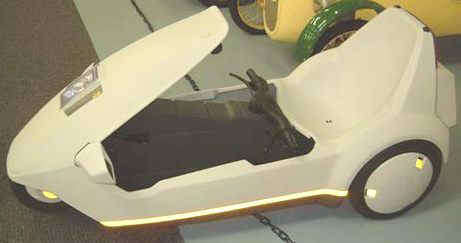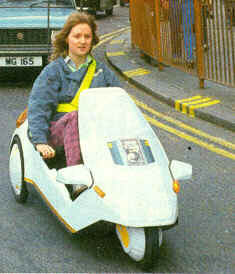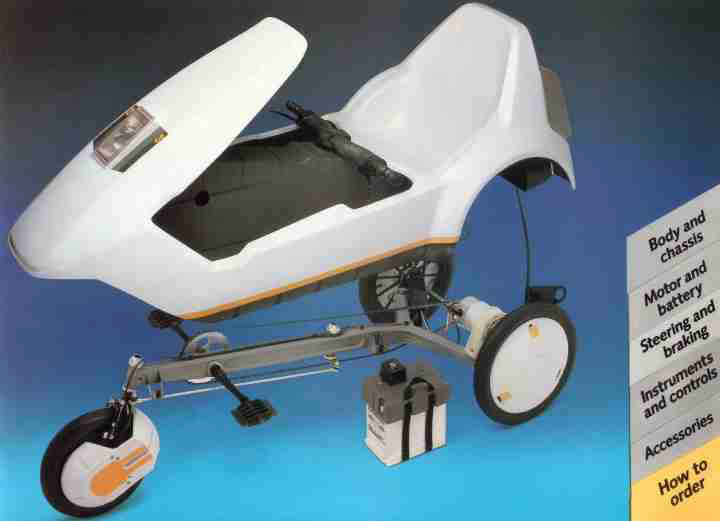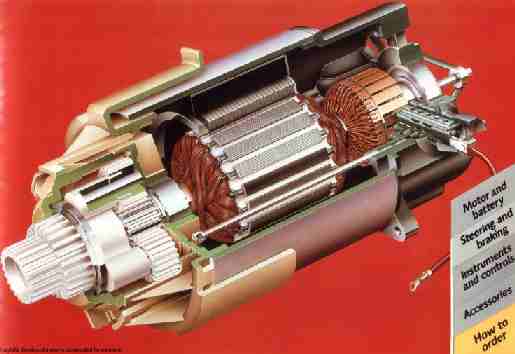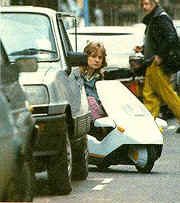|
||||||||||||||||||||||||
|
The Sinclair C5 was first launched in the UK on the 10th January 1985. Created by the innovator and inventor Sir Clive Sinclair, most famous for his ZX80 and ZX81 personal computers from 1980, the C5 was a revolutionary electric vehicle weighing in at just 99lbs. The vehicle used a 33lb lead acid battery that powered a 250 watt Hoover electric motor similar to those found in washing machines. As the C5 was created to fall in line with the 1983 Electrically Assisted Pedal Cycle Regulations, this ruled that the vechicle's engine could not exceed 250 watts in power. This therefore gave the C5 a top speed of 15 mph with a claimed 20 miles battery life in between charges. The vehicle also had pedals for extra assistance up hills.
The Sinclair C5
Sir Clive Sinclair was a very rich, eccentric genius who amassed a fortune in the manufacture of revolutionary- indeed visionary- electronic devices and products. These include calculators, watches, meters, pocket TV's(1975), micro computers (1980), and home computers (1982- when computers were still in dedicated rooms).
Like TV and computers, the idea of producing an electric vehicle had been a constant preoccupation for him. In the '70's, ecological issues were in the forefront, and the British government passed legislation that allowed electric-assisted cycles to be used without a license, as long as they didn’t exceed 15mph. Sinclair's directors were critical of spending corporate money on this type of research, so Sir Clive sold a small fraction of his company shares which netted 12 million pounds for the cause. The chassis design was by Lotus, the motor by Polymotor, and the polypropylene body the largest one-piece injection moulding ever made at the time. After negotiations for the former DeLorean plant failed, the C5 was built in a Hoover factory in Wales.
The Sinclair C5 on the road
The much-publicized launch was an unqualified disaster. It was held in the middle of winter and the C5's bodies skated on the snow. The press was merciless. Safety and Advertising Standards organizations got involved. Sales and production nosedived, and the company was wound up in October of the same year, with an unfazed Sir Clive out of pocket some 8.6 million pounds.
Manufacturer: Sinclair Vehicles, Camberley, Surrey, England
From day one of its launch the Sinclair C5 came under continuous attack from the media who criticised it for numerous reasons and said that it should be banned. The main reasons were that due to its low stance on the road it could not be seen easily by other road users, this also opened up the debate about C5 drivers being at the same level as exhaust pipes from larger vehicles and inhaling their fumes.
In addition the C5's power performance was also criticised as it was stated that often during independent test the vehicle could rarely tackle a hill climb without manual assistance peddling. It was also claimed that the vehicle only ever lasted approximately 10 miles on one battery charge and not the 20 specified by Sinclair. In some case this was reduced to 6 - 7 miles in winter as the cold would affect the battery's performance. A high visibility mask was available for the C5 as an optional extra though many claimed it should have been standard. Despite most of these claims made by the media condeming the vehicle, RoSPA stated that they liked the C5 and that it should not be banned.
As a result of these problems the Sinclair quickly gained a bad reputation and interest in sales plummeted. The vehicle had originally been planned as a mail order vehicle and was sold on the high street through Electrical retailers. Due to the lack of sales prices fell to just £199 from the previous £399 in a bid to sell surplus stock. On the 15 October 1985, Sir Clive Sinclair announced that Sinclair Vehicles had officially been placed in the hands of the receiver four days earlier and production of the C5 ceased. Later Sinclair unveiled plans that they may be modified to make a C10 ( a two seater version) and a C15 (a four seater version.). It was also rumoured during the 1990's that Sinclair was one of the People interested in the Reliant Motor Company when that went into receivership. Possibly with a plan to convert the Reliant Robin into an electric vehicle?
The main C5 body was moulded in two halves - the dark grey lower body, and the white upper body. The body of the C5 was made of self-coloured lightweight polypropylene. The vehicle was 2ft 6" wide, 2ft 6" high and 5ft 9" long. The two halves were joined using a thermo-plastic tape. This was tacked into place using a telesonic gun to the lower body. The upper body was held in position by an inflated band, and a current passed through the tape. This melted the tape, and joined the two halves together.
The bodyshell components were moulded in the ICI plastic, polypropylene. The upper body assembly was the largest mass-produced injection-moulded assembly ever made. The body shells were moulded by LinPac, one of the World's largest injection moulding specialists.
The Sinclair C5 frame and body
Possibly Sinclair's most famous product (albeit for quite the wrong reasons), the ill-conceived C5 "electric car" proved to be the point at which Sinclair Research's wheels finally fell off. Attracting controversy and derision in equal measure, the C5 fiasco ended up having a catastrophic effect on Sinclair's finances. Losses of up to £7 million eventually forced the company to sell its computer business to Amstrad.
The C5 was promoted by Sinclair as a revolutionary advance in personal transport with the potential to replace the car. The original intention was that it would be only the first in a whole series of electric vehicles - it would have been followed the never-released C10 and C15, each successively bigger and looking more like conventional vehicles. At only £399, the C5 was a fraction of the price of a conventional car. In fact, it was not a car at all but was instead a glorified electric tricycle, powered by an electric battery with a supplementary pedal drive. It did not inspire confidence that the C5 was assembled and serviced by Hoover, better known for its washing machines, which led to unkind comparisons being made between the two product lines.
THE C5 USED A WASHING MACHINE MOTOR
The C5 motor is a 12v DC permanent magnet motor, rated at 250W continuous. The motor was made by Polymotor in Italy, part of the giant Philips group. While it is true that Polymotor make motors for washing machines, it is also true that they make torpedo motors! Perhaps it would have sounded better if the C5 was powered by a torpedo motor! Being a 12v DC motor, it is far removed from the AC motor used in a washing machine anyway. Another example of "a little knowledge is a dangerous thing..."
The Sinclair C5 motor
The machine had several major flaws which doomed it before it had even been launched. It was capable of only 15 mph (a deliberate design decision, as electric vehicles which could travel faster than that required a licence to use). It had a very limited range which varied according to weather conditions - as little as 10km in cold weather - and its weight made it a struggle to pedal. Its cockpit was exposed to the elements (a real problem in the British climate) and the C5 itself was worryingly vulnerable in traffic. In a country with dedicated bicycle paths, such as the Netherlands, this would have been much less of a problem, but crowded British roads were a very different environment. This, probably more than anything else, sank the C5, not least because Sinclair initially did not publicly acknowledge the problem:
The "hi-vis mast" initially had to be purchased separately, but public pressure by the RoSPA and media eventually forced Sinclair to include it in the C5 package. By then, though, the damage had been done and even then it failed to satisfy everyone. The safety aspect so worried the authorities in the Netherlands, the most cyclist-friendly country in Europe, that the C5 was banned outright. Fewer than 17,000 C5s were sold, mostly in Britain although a few made it to continental Europe and the United States, and production was halted after only a few months. Some were reputedly bought by shipping companies to ferry deckhands around the huge foredecks of oil tankers.
The Sinclair C5 overtaking!
C5s are now highly sought-after collector's items and now sell for up to £900, although £300-£400 is a more likely value. One British stuntman has even turbocharged a C5 to 70mph (!) and races it through tunnels of fire. Sir Clive Sinclair would no doubt have known what that felt like in the wake of the C5's hostile reception.
See
also http://dmoz.org/Science/Technology/Energy/Transportation/Electric_Vehicles/Sinclair_C5
The Site for Sinclair C5 Enthusiasts Worldwide
Happy 20th Birthday C5! 10th January 1985 - 10th January 2005
The
Sinclair C5 was a commercial disaster. The Press hounded it as a dangerous
joke. Most of the attention the C5 got was negative - some with good foundation, but much without. This
site is dedicated to show you the positive side of the C5 - the
research and development -
WHAT'S NEW:
LINKS:
For further C5 information, follow the links below: The C5 Club - free email list with lots of topical postings
C5Alive.co.uk - C5 Spares online from including tyres/tubes Sinclair Research - with details of C5 spares from Adam Harper Chris Crosskey's End to End C5 Charity Drive site Pat Marsh from BBC Radio Kent has this Ferrari-red C5 to raise money for charity Planet Sinclair - Sinclair archive site Enrico Tedeschi's information on everything Sinclair
|
||||||||||||||||||||||||
|
The
content of this website is copyright © and design copyright 1991 and
2005 Electrick Publications and NJK. All rights reserved. The bird |
